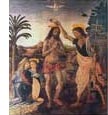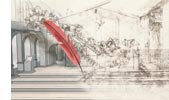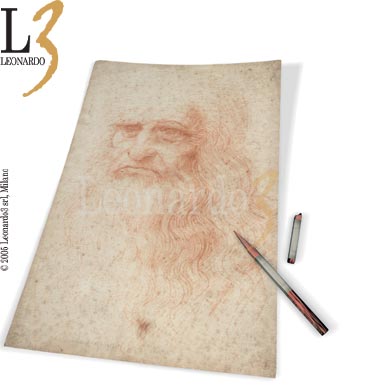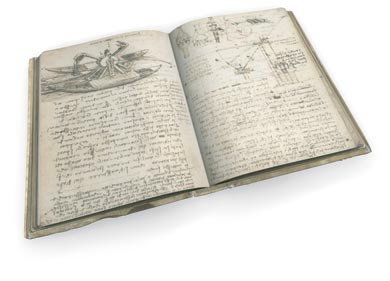Leonardo da Vinci
The Life
 1452
1452
15 April. Leonardo is born in Anchiano, near Vinci (in the province of Florence). Illegitimate son of the notary, ser Piero and a young peasant woman. Leonardo spends his childhood and early adolescence in Anchiano and Vinci. He lives with his father who, in the meantime, marries Albiera degli Amadori.
1466
After Albiera dies, he moves to Florence with his father.
1469
Joins the studio of Andrea del Verrocchio, much frequented by celebrated artists and young talented men where he learns to draw, paint and sculpt.

1471
Works on the completion of an angel in the Baptism of Christ painted in Verrocchio’s studio.
1472
Listed as a member of the Company of St. Luke, the Florentine artists’ guild. It is from this date that we begin to see his first independent works.
1476
Is accused, prosecuted and found not guilty of sodomy.
1481
Receives another commission. The friars at the church of San Donato in Scopeto, near Florence, request him to paint an altarpiece for their monastery. Leonardo begins work on the Adoration of the Magi, which he is never to complete.
1482
Leaves Florence to enter the service of Ludovico Sforza, nicknamed “the Moor”, the Seigneur of Milan, to whom he addresses a famous letter in which he lists his technical “secrets” and offers his services as engineer, architect, sculptor, painter and even musician. Leonardo lives approximately twenty years in Milan, painting, drawing, designing buildings and engineering projects.
1483
Signs a contract with the friars of the Immaculate Conception to paint the Virgin of the Rocks.
1489
Starts work on “The Horse”, the equestrian monument Ludovico wanted as a tribute to Francesco Sforza, his father. The statue, which was to be over 23 ft (7 meters) high and weigh around 71 tons (650 q), was never finished. Leonardo made the colossal clay model and the moulds for casting the bronze, but the model was later destroyed by French bowmen during the occupation of Milan in 1499.
1490
Paints the portrait of Cecilia Gallerani, the picture known as Lady with the ermine. Begins studying various areas of science and technology such as anatomy and hydraulics. Directs numerous court festivities.
1495
Starts painting The Last Supper, in the refectory of the monastery of Santa Maria delle Grazie.
1499
Leaves Milan in the company of Luca Pacioli a few months after French troops occupy the city.
|
|
 
1500
After staying in Mantua and Venice (where he draws up a plan of defence against Turkish invasion), returns to Florence and lodges at the monastery of the Servants of the Annunciation.
1502
For a few months, is in the service of Cesare Borgia who is involved in a number of military operations in Romagna and requests his assistance as a military engineer.
1503
In Florence, he begins work on the Mona Lisa. The Seigneury commissions him to create a fresco of the Battle of Anghiari, but the work, for which he uses experimental painting techniques, will not survive very long. In the same year, he resumes his studies on flight and on anatomy.
1504
His father, Piero, dies at the age of 80. Leonardo continues work on the Battle of Anghiari and plans the canal project of the River Arno.
1506
Returns to Milan, where he stays for three months at the insistence of the French Governor, Charles d’Amboise. Is appointed artist and engineer to King Louis XII.
1508
Again returns to Milan in the service of the French.
1513
On 24 September he moves to Rome, where he resides in the Vatican, in the service of Giuliano dei Medici, the brother of Pope Leo X. Continues to paint and study. Makes plans for the port of Civitavecchia.
1516
Moves to France at the invitation of the new King François I and lodges in the manor of Cloux, near the royal castle of Amboise.
1519
On 23 April he makes his last Will and Testament, designating his pupil Francesco Melzi heir to all his manuscripts and instruments. He leaves the paintings still in his studio (including the Mona Lisa, Saint Jerome and Saint Anne) to his other pupil, Salai. He dies on 2 May and is buried in the town of Amboise, in the cloister of the church of Saint Florentin. There is no longer any trace of his remains (which were later to be moved to the chapel of Saint Hubert inside the castle) because many tombs were destroyed during the sixteenth-century Wars of Religion.
|
Over 5,000 pages of Leonardo’s entire production are still available today. This enormous number of manuscripts is subdivided very differently from how it was originally organized and is distributed among a variety of separate codices (which were assembled long after Leonardo’ death; even the name “codex” is of a later date):
A, B, C, D, E, F, G, H, I, K, L, M
There are twelve paper manuscripts preserved at the Institut de France in Paris some of these are bound in parchment, leather or cardboard. They have different sizes, the smallest is Codex M (3.9 x 2.8 in. - 10 x 7 cm) and the largest Codex C (12.4 x 8.7 in. – 31.5 x 22 cm). Each is traditionally identified by a letter of the alphabet, from A to M (omitting J) and together they comprise 964 folios. The subjects range from the military arts, optics, geometry, to the flight of birds and hydraulics. Probable date: 1492-1516.
Arundel
This is held at the British Library in London. It is an unbound (since 1991) collection of 283 pages of different formats. These pages came from unbound manuscripts and have subsequently been glued onto backing sheets (11.0 x 7.1 in. - 28 x 18 cm). They cover a variety of disciplines: studies in physics and mechanics, optics and Euclidean geometry, weights and architecture (the last two include the works for the royal residence of François I at Ramorantin, in France). It was acquired by the British Lord Arundel in Spain circa 1630. Probable date: 1478-1518.
Ashburnham
Traditionally identified by two numbers: 2037 e 2038, these are preserved in Paris, at the Institut de France. Bound in cardboard, the two manuscripts are written on paper (9.5 x 7.5 in. - 24 x 19 cm) and originally formed part of Codex A, having been torn out by Guglielmo Libri in the middle of the 19th century. They mainly contain artistic studies (2038) and a miscellaneous group of other subjects (2037). Probable date: 1489-1492.
Atlanticus
Preserved at the Biblioteca Ambrosiana in Milan, the Codex Atlanticus is a collection of designs and annotations. It contains a wide variety of subjects: studies in mathematics, geometry, astronomy, botany, zoology, the military arts and many other subjects. As it stands today, it has been rearranged into twelve leather-bound volumes comprising 1119 backing sheets measuring (25.6 x 17.3 in. - 65 x 44 cm) containing manuscripts of various dimensions. Probable date: 1478-1518.
Forster I, II e III
Preserved in London, at the Victoria and Albert Museum, these are three manuscripts on paper, bound in parchment, and known as Forster I (54 folios, 5.7 x 3.9 in. – 14.5 x 10 cm), Forster II (158 folios, 7.7 x 2.8 in. - 19.5 x 7 cm) and Forster III (94 folios, 3.5 x 2.4 in. - 9 x 6 cm). They contain studies on geometry, physics, hydraulic machines, architecture and other subjects. Probable date: 1487-1505.
Hammer (formerly Codex Leicester)
Acquired in 1994 by Bill Gates, this is a manuscript on paper, bound in leather and composed of 18 double sheets, i.e. 36 folios (counting front and back) of (11.4 x 8.7 in. - 29 x 22 cm) dedicated mainly to studies on hydraulics and the movement of water. There are also some studies on astronomy. The name comes from the last owner, the American, Armand Hammer; previously it had been known as the Codex Leicester, after its owner Thomas Coke, Count of Leicester, who bought it in 1717. Probable date: 1506-1510. |
|

Madrid I and II
These two manuscripts were rediscovered only in 1966 at the National Library in Madrid, Spain. Their existence was unknown because they had been erroneously catalogued. Madrid I contains 184 sheets (8.3 x 5.9 in. - 21 x 15 cm) dedicated to mechanisms of various kinds (including clocks) and to studies on mechanical theory. Madrid II is composed of two manuscripts totaling 157 sheets (8.3 x 5.9 in. - 21 x 15 cm); the most remarkable designs and notes concern the project to divert the course of the Arno River, the Battle of Anghiari, perspectives and optics, and the casting of the monument to Francesco Sforza. Probable date: 1490-1508 for Madrid I, 1491-1505 for Madrid II.
Trivulzianus
This is preserved at the Trivulziana Library in the Sforza castle in Milan and consists of a volume composed of 51 folios (8.1 x 5.5 in. - 20.5 x 14 cm) in respect to the 62 original folios. In addition to studies on military and religious architecture, many pages relate to studies which Leonardo made with the intention of improving his literary development. Probable date: 1487-1490.
On the flight of birds
Located at the Biblioteca Reale in Turin, this Codex consists of 18 pages (8.3 x 5.9 in. - 21 x 15 cm) as compared to the 18 originally present. It is mainly concerned with the mechanics of how birds fly, in which Leonardo analytically studies a way to reproduce the mechanical structure in relation to his studies on the wing, air resistance, winds and currents. Probable date: 1505.
Windsor
There are 234 unbound folios of different sizes preserved in the Royal Collection at Windsor Castle in Great Britain. The collection contains approximately 600 drawings of anatomic studies, geography, studies of horses, sketches and caricatures, and a series of maps. Probable date: 1478-1518. |

![]()
![]()












